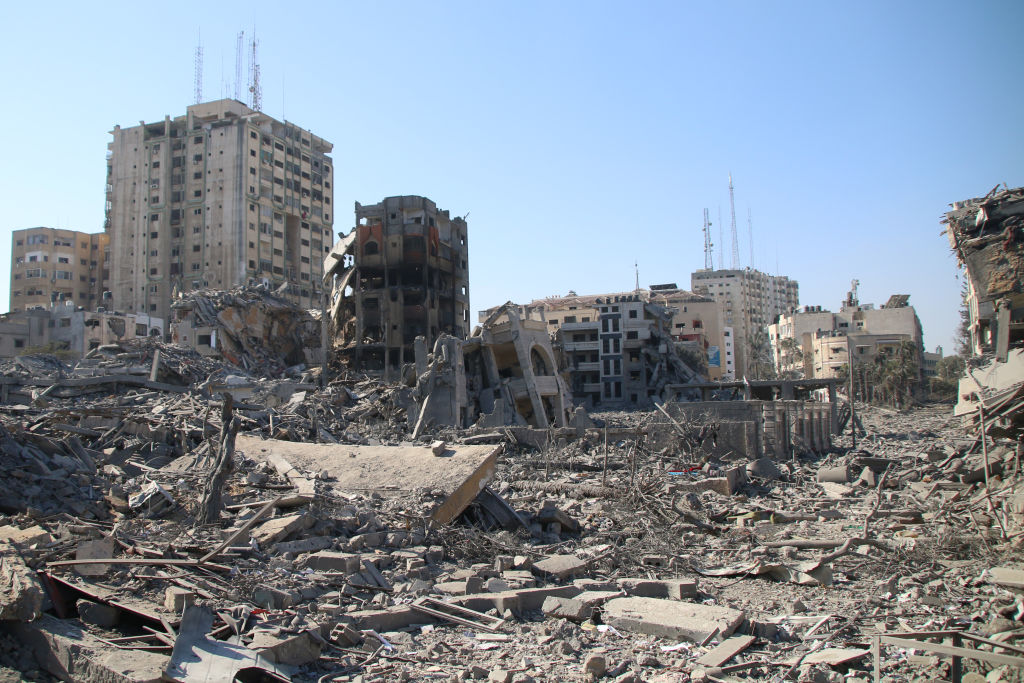
Israeli forces have encircled Gaza City and divided the enclave in two, IDF spokesperson Daniel Hagari told Israeli media yesterday. The announcement came ahead of an expected push into Gaza City on Monday or Tuesday, setting the stage for a bloodier phase of the war.
“From today going forward, there is North Gaza and South Gaza,” Hagari said. “The forces reached the coastline today. We are still allowing a humanitarian corridor for the residents of the northern Gaza Strip to descend south. It is a one-way corridor for those descending south, and we will continue to intensify the operation in northern Gaza.”
As the push looks set to start imminently, here’s what to know.
What is Israel’s military strategy in Gaza City?
Since the beginning of the ground operation on Oct. 27, the IDF said it has carried out operations against 2,500 targets in the Strip. But Hamas has at least 300 miles worth of tunnels where it stores its most valuable possessions, says John Spencer, retired U.S. Army Officer and chair of Urban Warfare Studies at the Madison Policy Forum foundation in New York. “Almost all of Hamas’s military capabilities are underground, most of it can’t be hit by aerial bombardment,” Spencer says. “Everything from its actual leadership to the rockets that it uses to fire on Israel are all underground.”
Spencer says that Israel will likely avoid sending its soldiers underground into Hamas’s tunnels, and he expects around 70% of the fighting to stay above ground on the streets of Gaza. “Any military would reduce the amount of time they ever put a soldier underground as much as possible. So I think the amount of fighting underground will actually be very limited,” he says.
More From TIME
That’s in part because key military equipment—like night vision goggles that rely on ambient light, communication tools that depend on satellites, and GPS systems—won’t work underground.
For these reasons, Spencer says, the Israeli military is likely to opt for destroying the tunnels wherever possible. They can do this by filling them with cement, bulldozing entrances and exits, or flooding them with sea water. But the presence of Israeli hostages in the tunnels will slow the Israeli military down and complicate operations. “Interviews we have gotten so far from released hostages have validated the theory that all of the hostages are underground,” Spencer says. “It definitely complicates what actions they can take when they discover a tunnel.”
Any street-to-street fighting could be particularly bloody. Hamas has an estimated 40,000 fighters and is expected to engage in classical guerilla warfare tactics, including ambushes and hit-and-run attacks. Hamas’s weapons arsenal has significantly advanced since the 2014 Gaza war—when fighting left 2,251 Palestinians and 73 Israelis dead—and now includes multiple drones, machine guns, AK-103 assault rifles, grenades, and Iranian made surface-to-air missiles, according to the Wall Street Journal.
Read More: ‘Our Death Is Pending.’ Stories of Loss and Grief From Gaza
“In every war, we surprise the Israelis with something new,” Ali Baraka, the Beirut-based spokesperson for Hamas’s external relations, told Reuters. In another interview with Russia Today TV, he added, “We have been preparing for this for two years. We have local factories for everything. We have rockets with ranges of 250 kms, 160 kms, 80 kms, 45 kms, and 10 kms.”
Gaza’s terrain might make it even deadlier for civilians than urban warfare in Iraq and Syria, says Amos Fox, a researcher at the University of Reading who studies irregular warfare.
“It's like an explosion in a room or in a building versus an explosion outdoors. It's just going to amplify the effects of that,” Fox says. “There's not going to be much opportunity for folks to get away from the conflict and also not not much of an opportunity for military forces that are trapped within those areas to get away.”
Can Israel destroy Hamas’s military capabilities?
Despite major obstacles, Spencer believes that the IDF is capable of destroying Hamas’s military capabilities. He thinks that the biggest challenge facing Israel is time as international pressure mounts against the war, which has so far left at least 10,000 people in Gaza dead, 6,700 of them women and children.
Fox, however, is more skeptical. He says he has seen similar rhetoric with U.S. military objectives to defeat the Taliban in Afghanistan and Al-Qaeda in Iraq. “Those types of goals are good for rallying support internally with your own folks. But realistically speaking, those goals are almost always unattainable because it's hard to eliminate an idea or ideology, and a people that are operating on that ideology, especially given the geopolitical situation that existed there since 1948.”
Nevertheless, both Fox and Spencer agree that pressure from the international community may play a huge role in the ultimate outcome of the war. Hundreds of thousands of people across the globe have demonstrated against Israeli airstrikes in Gaza and called for a ceasefire.
“War is not just about defeating your enemy, it’s about defeating the will of your enemy. Any defender will lose with enough time, but the tunnels allow them to stay alive and slow the IDF down until they get told to stop [by the international community],” Spencer says.
More Must-Reads From TIME
- What Student Photojournalists Saw at the Campus Protests
- How Far Trump Would Go
- Why Maternity Care Is Underpaid
- Saving Seconds Is Better Than Hours
- Why Your Breakfast Should Start with a Vegetable
- Welcome to the Golden Age of Ryan Gosling
- The 100 Most Influential People of 2024
- Want Weekly Recs on What to Watch, Read, and More? Sign Up for Worth Your Time
Contact us at letters@time.com